Roohallah Alizadehsani
Hoda
No-Reference Image Contrast Assessment with Customized EfficientNet-B0
Sep 26, 2025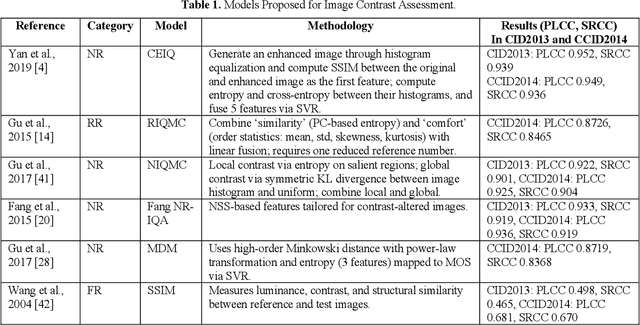

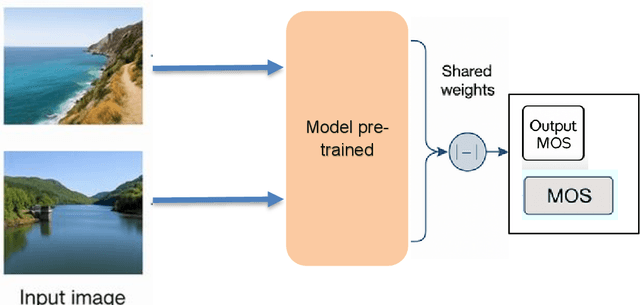

Abstract:Image contrast was a fundamental factor in visual perception and played a vital role in overall image quality. However, most no reference image quality assessment NR IQA models struggled to accurately evaluate contrast distortions under diverse real world conditions. In this study, we proposed a deep learning based framework for blind contrast quality assessment by customizing and fine-tuning three pre trained architectures, EfficientNet B0, ResNet18, and MobileNetV2, for perceptual Mean Opinion Score, along with an additional model built on a Siamese network, which indicated a limited ability to capture perceptual contrast distortions. Each model is modified with a contrast-aware regression head and trained end to end using targeted data augmentations on two benchmark datasets, CID2013 and CCID2014, containing synthetic and authentic contrast distortions. Performance is evaluated using Pearson Linear Correlation Coefficient and Spearman Rank Order Correlation Coefficient, which assess the alignment between predicted and human rated scores. Among these three models, our customized EfficientNet B0 model achieved state-of-the-art performance with PLCC = 0.9286 and SRCC = 0.9178 on CCID2014 and PLCC = 0.9581 and SRCC = 0.9369 on CID2013, surpassing traditional methods and outperforming other deep baselines. These results highlighted the models robustness and effectiveness in capturing perceptual contrast distortion. Overall, the proposed method demonstrated that contrast aware adaptation of lightweight pre trained networks can yield a high performing, scalable solution for no reference contrast quality assessment suitable for real time and resource constrained applications.
Uncertainty-Aware Deep Learning for Automated Skin Cancer Classification: A Comprehensive Evaluation
Jun 12, 2025Abstract:Accurate and reliable skin cancer diagnosis is critical for early treatment and improved patient outcomes. Deep learning (DL) models have shown promise in automating skin cancer classification, but their performance can be limited by data scarcity and a lack of uncertainty awareness. In this study, we present a comprehensive evaluation of DL-based skin lesion classification using transfer learning and uncertainty quantification (UQ) on the HAM10000 dataset. In the first phase, we benchmarked several pre-trained feature extractors-including Contrastive Language-Image Pretraining (CLIP) variants, Residual Network-50 (ResNet50), Densely Connected Convolutional Network (DenseNet121), Visual Geometry Group network (VGG16), and EfficientNet-V2-Large-combined with a range of traditional classifiers such as Support Vector Machine (SVM), eXtreme Gradient Boosting (XGBoost), and logistic regression. Our results show that CLIP-based vision transformers, particularly LAION CLIP ViT-H/14 with SVM, deliver the highest classification performance. In the second phase, we incorporated UQ using Monte Carlo Dropout (MCD), Ensemble, and Ensemble Monte Carlo Dropout (EMCD) to assess not only prediction accuracy but also the reliability of model outputs. We evaluated these models using uncertainty-aware metrics such as uncertainty accuracy(UAcc), uncertainty sensitivity(USen), uncertainty specificity(USpe), and uncertainty precision(UPre). The results demonstrate that ensemble methods offer a good trade-off between accuracy and uncertainty handling, while EMCD is more sensitive to uncertain predictions. This study highlights the importance of integrating UQ into DL-based medical diagnosis to enhance both performance and trustworthiness in real-world clinical applications.
Enhancing Monte Carlo Dropout Performance for Uncertainty Quantification
May 21, 2025Abstract:Knowing the uncertainty associated with the output of a deep neural network is of paramount importance in making trustworthy decisions, particularly in high-stakes fields like medical diagnosis and autonomous systems. Monte Carlo Dropout (MCD) is a widely used method for uncertainty quantification, as it can be easily integrated into various deep architectures. However, conventional MCD often struggles with providing well-calibrated uncertainty estimates. To address this, we introduce innovative frameworks that enhances MCD by integrating different search solutions namely Grey Wolf Optimizer (GWO), Bayesian Optimization (BO), and Particle Swarm Optimization (PSO) as well as an uncertainty-aware loss function, thereby improving the reliability of uncertainty quantification. We conduct comprehensive experiments using different backbones, namely DenseNet121, ResNet50, and VGG16, on various datasets, including Cats vs. Dogs, Myocarditis, Wisconsin, and a synthetic dataset (Circles). Our proposed algorithm outperforms the MCD baseline by 2-3% on average in terms of both conventional accuracy and uncertainty accuracy while achieving significantly better calibration. These results highlight the potential of our approach to enhance the trustworthiness of deep learning models in safety-critical applications.
A machine learning approach for Premature Coronary Artery Disease Diagnosis according to Different Ethnicities in Iran
Jan 31, 2025Abstract:Premature coronary artery disease (PCAD) refers to the early onset of the disease, usually before the age of 55 for men and 65 for women. Coronary Artery Disease (CAD) develops when coronary arteries, the major blood vessels supplying the heart with blood, oxygen, and nutrients, become clogged or diseased. This is often due to many risk factors, including lifestyle and cardiometabolic ones, but few studies were done on ethnicity as one of these risk factors, especially in PCAD. In this study, we tested the rank of ethnicity among the major risk factors of PCAD, including age, gender, body mass index (BMI), visceral obesity presented as waist circumference (WC), diabetes mellitus (DM), high blood pressure (HBP), high low-density lipoprotein cholesterol (LDL-C), and smoking in a large national sample of patients with PCAD from different ethnicities. All patients who met the age criteria underwent coronary angiography to confirm CAD diagnosis. The weight of ethnicity was compared to the other eight features using feature weighting algorithms in PCAD diagnosis. In addition, we conducted an experiment where we ran predictive models (classification algorithms) to predict PCAD. We compared the performance of these models under two conditions: we trained the classification algorithms, including or excluding ethnicity. This study analyzed various factors to determine their predictive power influencing PCAD prediction. Among these factors, gender and age were the most significant predictors, with ethnicity being the third most important. The results also showed that if ethnicity is used as one of the input risk factors for classification algorithms, it can improve their efficiency. Our results show that ethnicity ranks as an influential factor in predicting PCAD. Therefore, it needs to be addressed in the PCAD diagnostic and preventive measures.
Brain Ageing Prediction using Isolation Forest Technique and Residual Neural Network (ResNet)
Dec 26, 2024



Abstract:Brain aging is a complex and dynamic process, leading to functional and structural changes in the brain. These changes could lead to the increased risk of neurodegenerative diseases and cognitive decline. Accurate brain-age estimation utilizing neuroimaging data has become necessary for detecting initial signs of neurodegeneration. Here, we propose a novel deep learning approach using the Residual Neural Network 101 Version 2 (ResNet101V2) model to predict brain age from MRI scans. To train, validate and test our proposed model, we used a large dataset of 2102 images which were selected randomly from the International Consortium for Brain Mapping (ICBM). Next, we applied data preprocessing techniques, including normalizing the images and using outlier detection via Isolation Forest method. Then, we evaluated various pre-trained approaches (namely: MobileNetV2, ResNet50V2, ResNet101V2, Xception). The results demonstrated that the ResNet101V2 model has higher performance compared with the other models, attaining MAEs of 0.9136 and 0.8242 years for before and after using Isolation Forest process. Our method achieved a high accuracy in brain age estimation in ICBM dataset and it provides a reliable brain age prediction.
Functional Classification of Spiking Signal Data Using Artificial Intelligence Techniques: A Review
Sep 26, 2024Abstract:Human brain neuron activities are incredibly significant nowadays. Neuronal behavior is assessed by analyzing signal data such as electroencephalography (EEG), which can offer scientists valuable information about diseases and human-computer interaction. One of the difficulties researchers confront while evaluating these signals is the existence of large volumes of spike data. Spikes are some considerable parts of signal data that can happen as a consequence of vital biomarkers or physical issues such as electrode movements. Hence, distinguishing types of spikes is important. From this spot, the spike classification concept commences. Previously, researchers classified spikes manually. The manual classification was not precise enough as it involves extensive analysis. Consequently, Artificial Intelligence (AI) was introduced into neuroscience to assist clinicians in classifying spikes correctly. This review discusses the importance and use of AI in spike classification, focusing on the recognition of neural activity noises. The task is divided into three main components: preprocessing, classification, and evaluation. Existing methods are introduced and their importance is determined. The review also highlights the need for more efficient algorithms. The primary goal is to provide a perspective on spike classification for future research and provide a comprehensive understanding of the methodologies and issues involved. The review organizes materials in the spike classification field for future studies. In this work, numerous studies were extracted from different databases. The PRISMA-related research guidelines were then used to choose papers. Then, research studies based on spike classification using machine learning and deep learning approaches with effective preprocessing were selected.
Complex Emotion Recognition System using basic emotions via Facial Expression, EEG, and ECG Signals: a review
Sep 09, 2024
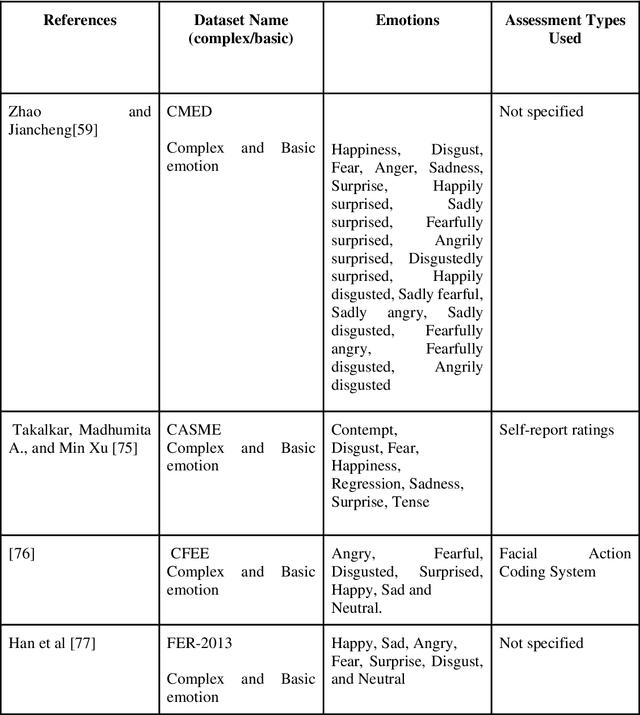

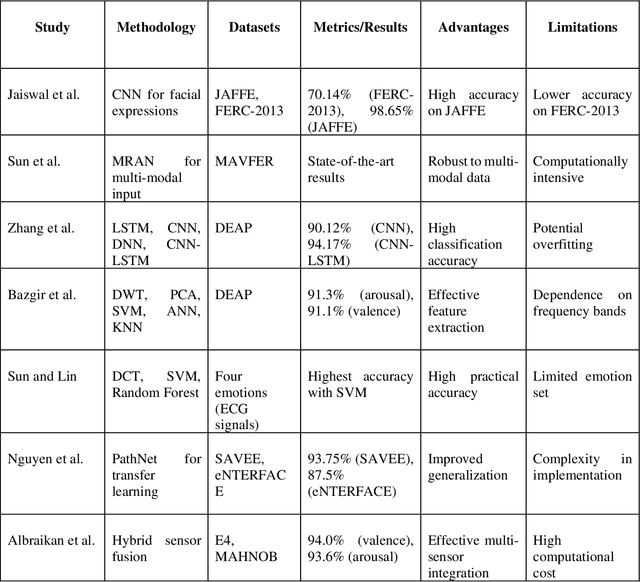
Abstract:The Complex Emotion Recognition System (CERS) deciphers complex emotional states by examining combinations of basic emotions expressed, their interconnections, and the dynamic variations. Through the utilization of advanced algorithms, CERS provides profound insights into emotional dynamics, facilitating a nuanced understanding and customized responses. The attainment of such a level of emotional recognition in machines necessitates the knowledge distillation and the comprehension of novel concepts akin to human cognition. The development of AI systems for discerning complex emotions poses a substantial challenge with significant implications for affective computing. Furthermore, obtaining a sizable dataset for CERS proves to be a daunting task due to the intricacies involved in capturing subtle emotions, necessitating specialized methods for data collection and processing. Incorporating physiological signals such as Electrocardiogram (ECG) and Electroencephalogram (EEG) can notably enhance CERS by furnishing valuable insights into the user's emotional state, enhancing the quality of datasets, and fortifying system dependability. A comprehensive literature review was conducted in this study to assess the efficacy of machine learning, deep learning, and meta-learning approaches in both basic and complex emotion recognition utilizing EEG, ECG signals, and facial expression datasets. The chosen research papers offer perspectives on potential applications, clinical implications, and results of CERSs, with the objective of promoting their acceptance and integration into clinical decision-making processes. This study highlights research gaps and challenges in understanding CERSs, encouraging further investigation by relevant studies and organizations. Lastly, the significance of meta-learning approaches in improving CERS performance and guiding future research endeavors is underscored.
Advancements in Radiomics and Artificial Intelligence for Thyroid Cancer Diagnosis
Apr 09, 2024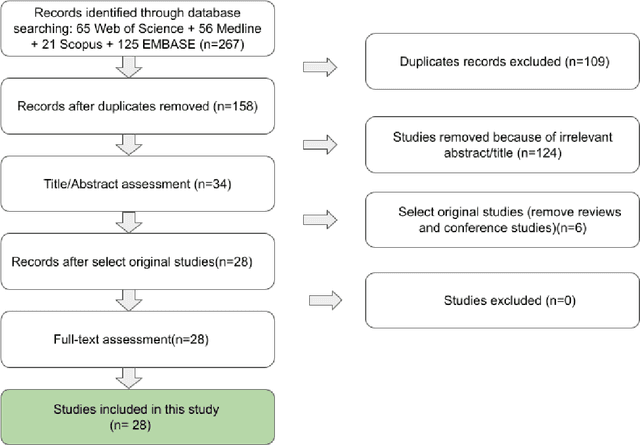
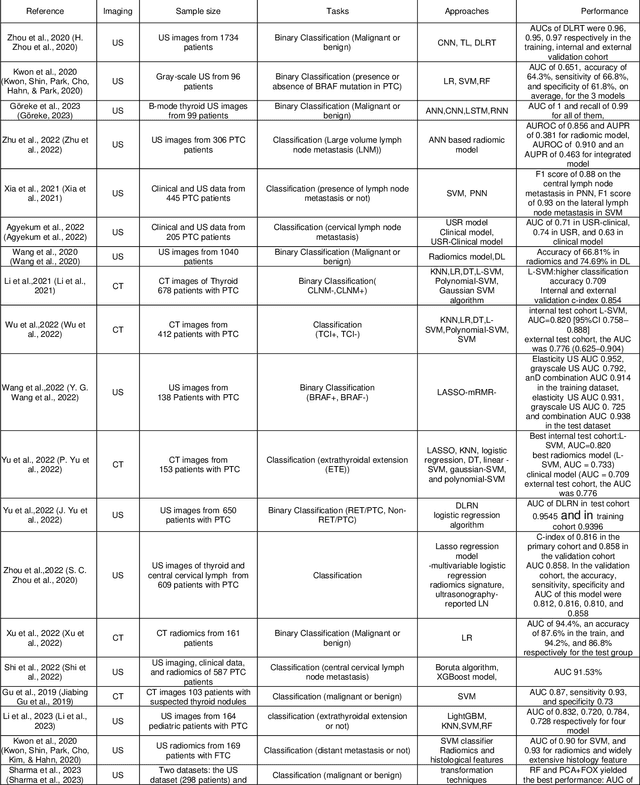
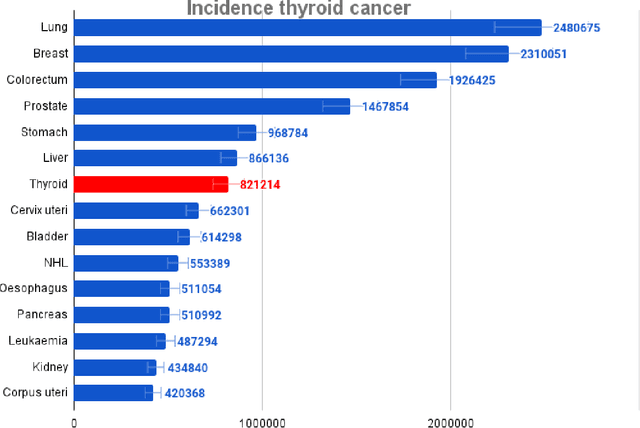
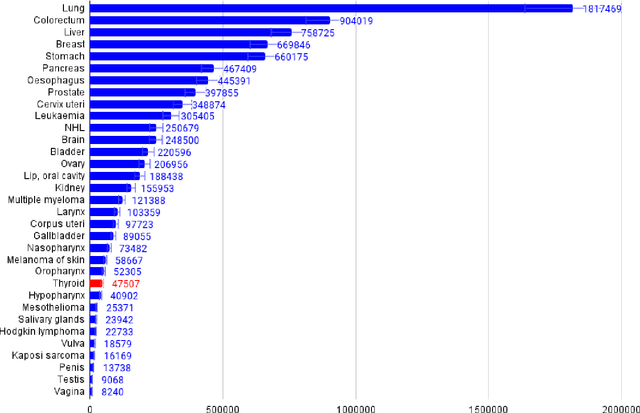
Abstract:Thyroid cancer is an increasing global health concern that requires advanced diagnostic methods. The application of AI and radiomics to thyroid cancer diagnosis is examined in this review. A review of multiple databases was conducted in compliance with PRISMA guidelines until October 2023. A combination of keywords led to the discovery of an English academic publication on thyroid cancer and related subjects. 267 papers were returned from the original search after 109 duplicates were removed. Relevant studies were selected according to predetermined criteria after 124 articles were eliminated based on an examination of their abstract and title. After the comprehensive analysis, an additional six studies were excluded. Among the 28 included studies, radiomics analysis, which incorporates ultrasound (US) images, demonstrated its effectiveness in diagnosing thyroid cancer. Various results were noted, some of the studies presenting new strategies that outperformed the status quo. The literature has emphasized various challenges faced by AI models, including interpretability issues, dataset constraints, and operator dependence. The synthesized findings of the 28 included studies mentioned the need for standardization efforts and prospective multicenter studies to address these concerns. Furthermore, approaches to overcome these obstacles were identified, such as advances in explainable AI technology and personalized medicine techniques. The review focuses on how AI and radiomics could transform the diagnosis and treatment of thyroid cancer. Despite challenges, future research on multidisciplinary cooperation, clinical applicability validation, and algorithm improvement holds the potential to improve patient outcomes and diagnostic precision in the treatment of thyroid cancer.
Artificial Intelligence and Diabetes Mellitus: An Inside Look Through the Retina
Feb 28, 2024



Abstract:Diabetes mellitus (DM) predisposes patients to vascular complications. Retinal images and vasculature reflect the body's micro- and macrovascular health. They can be used to diagnose DM complications, including diabetic retinopathy (DR), neuropathy, nephropathy, and atherosclerotic cardiovascular disease, as well as forecast the risk of cardiovascular events. Artificial intelligence (AI)-enabled systems developed for high-throughput detection of DR using digitized retinal images have become clinically adopted. Beyond DR screening, AI integration also holds immense potential to address challenges associated with the holistic care of the patient with DM. In this work, we aim to comprehensively review the literature for studies on AI applications based on retinal images related to DM diagnosis, prognostication, and management. We will describe the findings of holistic AI-assisted diabetes care, including but not limited to DR screening, and discuss barriers to implementing such systems, including issues concerning ethics, data privacy, equitable access, and explainability. With the ability to evaluate the patient's health status vis a vis DM complication as well as risk prognostication of future cardiovascular complications, AI-assisted retinal image analysis has the potential to become a central tool for modern personalized medicine in patients with DM.
Current and future roles of artificial intelligence in retinopathy of prematurity
Feb 15, 2024


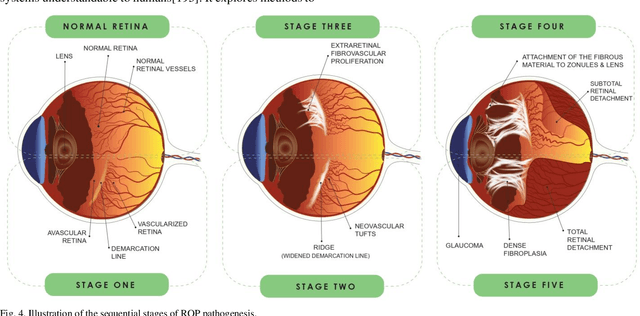
Abstract:Retinopathy of prematurity (ROP) is a severe condition affecting premature infants, leading to abnormal retinal blood vessel growth, retinal detachment, and potential blindness. While semi-automated systems have been used in the past to diagnose ROP-related plus disease by quantifying retinal vessel features, traditional machine learning (ML) models face challenges like accuracy and overfitting. Recent advancements in deep learning (DL), especially convolutional neural networks (CNNs), have significantly improved ROP detection and classification. The i-ROP deep learning (i-ROP-DL) system also shows promise in detecting plus disease, offering reliable ROP diagnosis potential. This research comprehensively examines the contemporary progress and challenges associated with using retinal imaging and artificial intelligence (AI) to detect ROP, offering valuable insights that can guide further investigation in this domain. Based on 89 original studies in this field (out of 1487 studies that were comprehensively reviewed), we concluded that traditional methods for ROP diagnosis suffer from subjectivity and manual analysis, leading to inconsistent clinical decisions. AI holds great promise for improving ROP management. This review explores AI's potential in ROP detection, classification, diagnosis, and prognosis.
 Add to Chrome
Add to Chrome Add to Firefox
Add to Firefox Add to Edge
Add to Edge